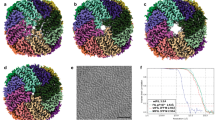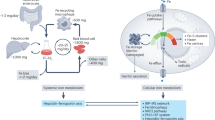Abstract
In mammalian cells, regulation of the expression of proteins involved in iron metabolism is achieved through interactions of iron-sensing proteins known as iron regulatory proteins (IRPs), with transcripts that contain RNA stem-loop structures referred to as iron responsive elements (IREs). Two distinct but highly homologous proteins, IRP1 and IRP2, bind IREs with high affinity when cells are depleted of iron, inhibiting translation of some transcripts, such as ferritin, or turnover of others, such as the transferrin receptor (TFRC). IRPs sense cytosolic iron levels and modify expression of proteins involved in iron uptake, export and sequestration according to the needs of individual cells1,2. Here we generate mice with a targeted disruption of the gene encoding Irp2 (Ireb2). These mutant mice misregulate iron metabolism in the intestinal mucosa and the central nervous system. In adulthood, Ireb2−/− mice develop a movement disorder characterized by ataxia, bradykinesia and tremor. Significant accumulations of iron in white matter tracts and nuclei throughout the brain precede the onset of neurodegeneration and movement disorder symptoms by many months. Ferric iron accumulates in the cytosol of neurons and oligodendrocytes in distinctive regions of the brain. Abnormal accumulations of ferritin colocalize with iron accumulations in populations of neurons that degenerate, and iron-laden oligodendrocytes accumulate ubiquitin-positive inclusions. Thus, misregulation of iron metabolism leads to neurodegenerative disease in Ireb2−/− mice and may contribute to the pathogenesis of comparable human neurodegenerative diseases.
This is a preview of subscription content, access via your institution
Access options
Subscribe to this journal
Receive 12 print issues and online access
$209.00 per year
only $17.42 per issue
Buy this article
- Purchase on Springer Link
- Instant access to full article PDF
Prices may be subject to local taxes which are calculated during checkout






Similar content being viewed by others
Accession codes
References
Rouault, T. & Klausner, R. Regulation of iron metabolism in eukaryotes. Curr. Top. Cell Regul. 35, 1–19 (1997).
Hentze, M.W. & Kuhn, L.C. Molecular control of vertebrate iron metabolism: mRNA-based regulatory circuits operated by iron, nitric oxide, and oxidative stress. Proc. Natl. Acad. Sci. USA 93, 8175–8182 (1996).
Kim, H.Y., Klausner, R.D. & Rouault, T.A. Translational repressor activity is equivalent and is quantitatively predicted by in vitro RNA binding for two iron-responsive element binding proteins, IRP1 and IRP2. J. Biol. Chem. 270, 4983–4986 (1995).
Beinert, H., Kennedy, M.C. & Stout, D.C. Aconitase as iron-sulfur protein, enzyme, and iron-regulatory protein. Chem. Rev . 96, 2335–2373 (1996).
Guo, B., Phillips, J.D., Yu, Y. & Leibold, E.A. Iron regulates the intracellular degradation of iron regulatory protein 2 by the proteasome. J. Biol. Chem. 270, 21645–21651 (1995).
Iwai, K. A. et al. Iron-dependent oxidation, ubiquitination, and degradation of iron regulatory protein 2: implications for degradation of oxidized proteins. Proc. Natl. Acad. Sci. USA 95, 4924–4928 (1998).
Wu, K.J., Polack, A. & Dalla-Favera, R. Coordinated regulation of iron-controlling genes, H-ferritin and IRP2, by c-MYC. Science 283, 676–679 (1999).
Sango, K. et al. Mice lacking both subunits of lysosomal β-hexosaminidase display gangliosidosis and mucopolysaccharidosis. Nature Genet. 14, 348–352 (1996).
Andrews, N.C., Fleming, M.D. & Gunshin, H. Iron transport across biologic membranes. Nutr. Rev. 57, 114–123 (1999).
Donovan, A. et al. Positional cloning of zebrafish ferroportin1 identifies a conserved vertebrate iron exporter. Nature 403, 776–781 (2000).
McKie, A.T. et al. A novel duodenal iron-regulated transporter, IREG1, implicated in the basolateral transfer of iron to the circulation. Mol. Cell 5, 299–309 (2000).
Abboud, S. & Haile, D.J. A novel mammalian iron-regulated protein involved in intracellular iron metabolism. J. Biol. Chem. 275, 19906–19912 (2000).
Francois, C., Nguyen-Legros, J. & Percheron, G. Topographical and cytological localization of iron in rat and monkey brains. Brain Res. 215, 317–322 (1981).
de Olmos, J.S., Beltramino, C.A. & de Olmos de Lorenzo, S. Use of an amino-cupric-silver technique for the detection of early and semiacute neuronal degeneration caused by neurotoxicants, hypoxia, and physical trauma. Neurotoxicol. Teratol. 16, 545–561 (1994).
Katz, R.L. et al. An intra-abdominal small round cell neoplasm with features of primitive neuroectodermal and desmoplastic round cell tumor and a EWS/FLI-1 fusion transcript. Hum. Pathol. 28, 502–509 (1997).
Henderson, B.R., Seiser, C. & Kuhn, L.C. Characterization of a second RNA-binding protein in rodents with specificity for iron-responsive elements. J. Biol. Chem. 268, 27327–27334 (1993).
Cozzi, A. et al. Overexpression of wild type and mutated human ferritin H-chain in HeLa cells: in vivo role of ferritin ferroxidase activity. J. Biol. Chem. 275, 25122–25129 (2000).
Love, P.E. et al. T cell development in mice that lack the zeta chain of the T cell antigen receptor complex. Science 261, 918–921 (1993).
Kim, H.Y., LaVaute, T., Iwai, K., Klausner, R.D. & Rouault, T.A. Identification of a conserved and functional iron-responsive element in the 5′ UTR of mammalian mitochondrial aconitase. J. Biol. Chem. 271, 24226–24230 (1996).
Ishino, K., Kaneyama, J., Shibanuma, M. & Nose, K. Specific decrease in the level of Hic-5, a focal adhesion protein, during immortalization of mouse embryonic fibroblasts, and its association with focal adhesion kinase. J. Cell. Biochem. 76, 411–419 (2000).
Allerson, C.R., Cazzola, M. & Rouault, T.A. Clinical severity and thermodynamic effects of iron-responsive element mutations in hereditary hyperferritinemia-cataract syndrome. J. Biol. Chem. 274, 26439–26447 (1999).
DeRusso, P.A. et al. Expression of a constitutive mutant of iron regulatory protein 1 abolishes iron homeostasis in mammalian cells. J. Biol. Chem. 270, 15451–15454 (1995).
Konijn, A.M., Levy, R., Link, G. & Hershko, C. A rapid and sensitive ELISA for serum ferritin employing a fluorogenic substrate. J. Immunol. Methods 54, 297–307 (1982).
Tam, J.P. Synthetic peptide vaccine design: synthesis and properties of a high-density multiple antigenic peptide system. Proc. Natl. Acad. Sci. USA 85, 5409–5413 (1988).
Fix, A.S. & Garman, R.H. Practical aspects of neuropathology: a technical guide for working with the nervous system. Toxicol. Pathol. 28, 122–131 (2000).
Fix, A.S., Ross, J.F., Stitzel, S.R. & Switzer, R.C. Integrated evaluation of central nervous system lesions: stains for neurons, astrocytes, and microglia reveal the spatial and temporal features of MK-801-induced neuronal necrosis in the rat cerebral cortex. Toxicol. Pathol. 24, 291–304 (1996).
Ellenberg, J. et al. Nuclear membrane dynamics and reassembly in living cells: targeting of an inner nuclear membrane protein in interphase and mitosis. J. Cell Biol. 138, 1193–1206 (1997).
Yin, X., Peterson, J., Gravel, M., Braun, P.E. & Trapp, B.D. CNP overexpression induces aberrant oligodendrocyte membranes and inhibits MBP accumulation and myelin compaction. J. Neurosci. Res. 50, 238–247 (1997).
Arai, N., Papp, M.I. & Lantos, P.L. New observation on ubiquitinated neurons in the cerebral cortex of multiple system atrophy (MSA). Neurosci. Lett. 182, 197–200 (1994).
Lyons, G.E., Schiaffino, S., Sassoon, D., Barton, P. & Buckingham, M. Developmental regulation of myosin gene expression in mouse cardiac muscle. J. Cell Biol. 111, 2427–2436 (1990).
Acknowledgements
We thank J. Gitlin for performing serum ceruloplasmin measurements; E.Mezey for help with detection of ubiquitin inclusions; A.M. Konijn for mouse liver ferritin and rabbit anti-mouse ferritin antiserum coupled to β-galactosidase; R. Levine for the overexpressed Irp2 degradation domain; and S. Landis and members of the Rouault group and Cell Biology and Metabolism Branch for suggestions. This work was supported by the Intramural program of the National Institute of Child Health and Human Development, and in part by the Lookout Fund.
Author information
Authors and Affiliations
Corresponding author
Rights and permissions
About this article
Cite this article
LaVaute, T., Smith, S., Cooperman, S. et al. Targeted deletion of the gene encoding iron regulatory protein-2 causes misregulation of iron metabolism and neurodegenerative disease in mice. Nat Genet 27, 209–214 (2001). https://doi.org/10.1038/84859
Received:
Accepted:
Issue Date:
DOI: https://doi.org/10.1038/84859
This article is cited by
-
Iron imbalance in neurodegeneration
Molecular Psychiatry (2024)
-
Mechanisms controlling cellular and systemic iron homeostasis
Nature Reviews Molecular Cell Biology (2024)
-
KLF14 regulates the growth of hepatocellular carcinoma cells via its modulation of iron homeostasis through the repression of iron-responsive element-binding protein 2
Journal of Experimental & Clinical Cancer Research (2023)
-
Cuproptosis-Related Ferroptosis genes for Predicting Prognosis in kidney renal clear cell carcinoma
European Journal of Medical Research (2023)
-
Iron response elements (IREs)-mRNA of Alzheimer's amyloid precursor protein binding to iron regulatory protein (IRP1): a combined molecular docking and spectroscopic approach
Scientific Reports (2023)



